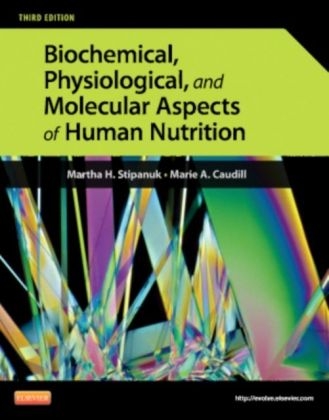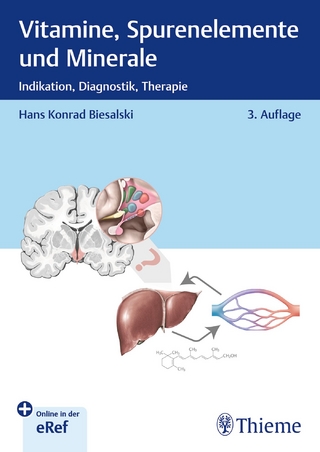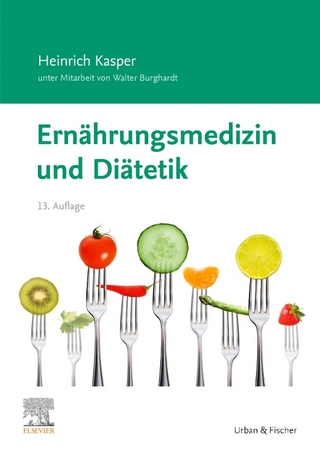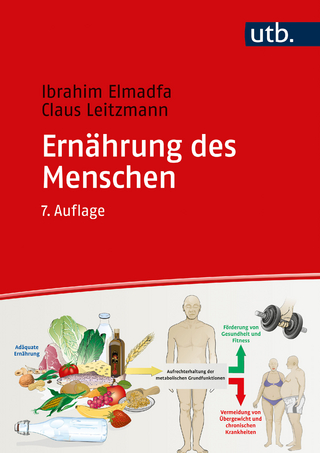
Biochemical, Physiological, and Molecular Aspects of Human Nutrition
Saunders (Verlag)
978-1-4377-0959-9 (ISBN)
- Titel erscheint in neuer Auflage
- Artikel merken
Covering advanced nutrition with a comprehensive, easy-to-understand approach, Biochemical, Physiological, and Molecular Aspects of Human Nutrition, 3rd Edition focuses on the biology of human nutrition at the molecular, cellular, tissue, and whole-body levels. It addresses nutrients by classification, and describes macronutrient function from digestion to metabolism. This edition includes the new MyPlate dietary guide and recommendations from the Dietary Guidelines for Americans 2010, plus coverage of the historical evolution of nutrition and information on a wide range of vitamins, minerals, and other food components. In Biochemical, Physiological, and Molecular Aspects of Human Nutrition, lead authors Martha H. Stipanuk and Marie A. Caudill are joined by a team of nutrition experts in providing clear, concise, coverage of advanced nutrition.
55 expert contributors provide the latest information on all areas of the nutrition sciences.
Nutrition Insight boxes discuss hot topics and take a closer look at basic science and everyday nutrition.
Clinical Correlation boxes show the connection between nutrition-related problems and their effects on normal metabolism.
Food Sources boxes summarize and simplify data from the USDA National Nutrient Database on the amount and types of foods needed to reach the recommended daily allowances for vitamins and minerals.
DRIs Across the Life Cycle boxes highlight the latest data from the Institute of Medicine on dietary reference intakes for vitamins and minerals, including coverage of infants, children, adult males and females, and pregnant and lactating women.
Life Cycle Considerations boxes highlight nutritional processes or concepts applicable to individuals of various ages and in various stages of the life span.
Thinking Critically sections within boxes and at the end of chapters help in applying scientific knowledge to "real-life" situations.
Lists of common abbreviations provide an overview of each chapter's content at a glance.
Comprehensive cross-referencing by chapters and illustrations is used throughout.
Current references and recommended readings connect you to nutrition-related literature and provide additional tools for research.
Coverage of the USDA's MyPlate dietary guide reflects today's new approach to diet and nutrition.
Recommendations outlined in the Dietary Guidelines for Americans 2010 are incorporated throughout the book.
Updated format features more subheadings, tables, and bullets, making it easier to learn and recall key points.
Updates of key chapters and boxes reflect significant changes within the fields of nutrition, biology, molecular biology, and chemistry.
NEW illustrations simplify complex biochemical, physiological, and molecular processes and concepts.
Unit I: Nutrients: Essential and Nonessential
1. Nutrients: History and Definitions
2. Nonessential Food Components with Health Benefits
3. Guidelines for Food and Nutrient Intake
Unit II: Structure and Properties of the Macronutrients
4. Structure, Nomenclature, and Properties of Carbohydrates
5. Structure and Properties of Proteins and Amino Acids
6. Lipid Structure, Nomenclature, and Chemical Properties
Unit III: Digestion and Absorption of the Macronutrients
7. Overview of Digestion and Absorption
8. Carbohydrate Digestion and Absorption
9. Digestion and Absorption of Protein
10. Digestion and Absorption of Lipids
11. Dietary Fiber
Unit IV: Metabolism of the Macronutrients
12. Carbohydrate Metabolism: Synthesis and Oxidation
13. Protein Synthesis and Degradation
14. Amino Acid Metabolism
15. Protein and Amino Acid Requirements
16. Metabolism of Fatty Acids, Acylglycerols, and Sphingolipids
17. Cholesterol and Lipoproteins: Synthesis, Transport, and Metabolism
18. Lipid Metabolism: Polyunsaturated Fatty Acids
19. Regulation of Fuel Utilization in Response to Food Intake
20. Regulation of Fuel Utilization in Response to Physical Activity
Unit V: Energy
21. Cellular and Whole-Animal Energetics
22. Control of Energy Balance
23. Disturbances of Energy Balance
Unit VI: The Vitamins
24. Niacin, Riboflavin and Thiamin
25. Folate, Choline, Folic Acid, Vitamin B12, and Vitamin B6
26. Biotin and Pantothenic Acid
27. Vitamin C
28. Vitamin K
29. Vitamin E
30. Vitamin A
31. Vitamin D
Unit VII: The Minerals and Water
32. Calcium and Phosphorus
33. Magnesium
34. Sodium, Chloride, and Potassium
35. Body Fluids and Water Balance
36. Iron
37. Zinc, Copper, and Manganese
38. Iodine
39. Selenium
40. Fluoride
41. Molybdenum and Beneficial Bioactive Trace Elements
| Verlagsort | Philadelphia |
|---|---|
| Sprache | englisch |
| Maße | 216 x 276 mm |
| Themenwelt | Medizin / Pharmazie ► Gesundheitsfachberufe ► Diätassistenz / Ernährungsberatung |
| ISBN-10 | 1-4377-0959-1 / 1437709591 |
| ISBN-13 | 978-1-4377-0959-9 / 9781437709599 |
| Zustand | Neuware |
| Informationen gemäß Produktsicherheitsverordnung (GPSR) | |
| Haben Sie eine Frage zum Produkt? |
aus dem Bereich



